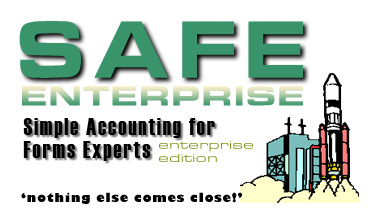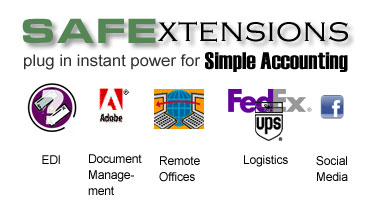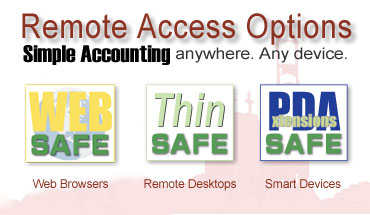Remote Office Extensions
 Synchronize Data From Multiple Offices
Synchronize Data From Multiple Offices
Remote Office Extensions (ROX for short) is a special extension to Simple Accounting which can intelligently transfer key data from itself to other copies of Simple Accounting software. This allows organizations with branch offices to each run separate copies of the software and always keep the data for each copy in sync with the information from all sites. ROX lets you do business at remote locations and always make sure that you have all
the information your main office does, and that the main office has all the information that you do.
Some Suggested Applications
There are many uses for ROX, but here are some highlights to get started:
| Working from Home? | ROX is perfect for those who wish to work at home regularly. |
| Remote Offices? | Set up your remote offices easily, and inexpensively with ROX. |
How It Works
To illustrate what ROX is and how it works, we’ll start with a common scenario: You are a salesperson with a company which uses Simple Accounting and you have just been assigned to work out of a branch office. You have a computer with a modem and your Main Office computer also has a modem. You’ve have just been given a copy of Simple Accounting (with ROX) so that you can enter and track your own customer orders at your Remote Office. You
install the software and begin doing your own order entry and contact management just like you always did at the Main Office. To you, ROX behaves no differently than regular Simple Accounting; you don’t notice any difference at all. But in the background the ROX part of your program is silently at work.
At five P.M. every day you have been instructed to turn on your computer and run Close-Up® communications software and go home (easy enough!). Some time during the night, the computer at your main office (also running Close-Up) automatically dials your computer, makes some funny noises for a few minutes, then hangs up.
In the morning, you start Simple Accounting and you notice that there is something different on your opening screen; a window informs you that you have new transactions waiting from the main office. You tell Simple Accounting to update your system with the new data and then wait a minute or so while the program `thinks.’
Afterwards, you start looking around in the program and you notice several things are different. You now have several new customers and sales contacts you didn’t have before. You also see that all your orders from last week have been invoiced for you. Further, checking A/R shows that a lot of your customers’ invoices now show up as being paid (that’s good, because paid invoices mean commission money!) Finally, your inventory is updated with the Main Office’s latest numbers. Meanwhile back at the Main Office, the new orders you entered today are now part of their system, just waiting to be invoiced.
So what happened? Each machine was updated with only the information it needed in order to be in sync with one another. You got the new customers, invoices, and sales information which are part of your territory, but you didn’t get information which is part of anyone else’s territory. The Main Office got your new orders, but not your older orders (because it already had those on file.) Now you and the Main Office both have the data you need to do your work as if you were both using Simple Accounting in the Main Office.
Important Points To Remember
| Data Transfer can be limited | Note that this does not mean that each machine now has an exact duplicate of each other’s data. ROX can be customized so that each side of the data transfer can get as much or as little data as your company wishes. In the example above, you only get data regarding your customers. You don’t get orders assigned to other salespeople. On the other hand, ROX can also be configured so that each remote site can receive all data from all sites. |
| Data is synchronized; not merely opied! | We are not simply overwriting one machine’s data with the others. For example, we’re not simply copying the Main Office computer’s customer file onto your computer. That would cause a loss of any customers you had in your system which were not already entered into the Main Office computer. What ROX does is incorporate the data from one machine into another without losing data. You get the Main Office’s new customers in your customer file and they get your new customers added to their customer file. |
| Data Integrity is assured! | Duplicates are not allowed. For example, if you send them a `new’ customer which is already on the Main Office computer, that customer is not added to their customer file; because it’s already a part of their file! If they send you an updated list of orders which have been invoiced, your copy of ROX will know this and replace those orders in your system with the updated orders from the Main Office. |
| Ownership is important! | This brings up the topic of ownership, ie. who has priority over a given piece of data. Since each copy of Simple Accounting is independent, it will sometimes occur that users at two offices will be editing the same thing, for example, a customer address or a sales order. The question then becomes, "who’se edits take priority?" The answer is simply, "whoever created the data, owns the data." And that means that if two sites are changing the same customer record, the site which first created the customer takes precedence; their edits will be sent to all other sites when data is next synchronized.
If a salesperson is working on a sales order she created, then her changes take priority. But once the order is billed, then the main office then takes over ownership (assuming that the main office is in charge of billing); at that point, their changes take precedence. |
Getting Data From Here To There
As you may have noted already, ROX does not provide the `transport’ for information from one machine to another. That is, it doesn’t actually take the data from one machine and put it into the other. For that we need either floppy disks, e-mail, or communications software such as Close-Up from Norton Lambert. To you, ROX works like any `regular’ Simple Accounting program; you aren’t even aware that anything is ‘happening.’ But in the background The ROX part of ROX is silently creating a variety of files, while you work, on both the Main Office machine and on the client machine. When you run Close-Up for example, the day’s work from your client machine is automatically uploaded to the host computer and the data you need is automatically sent back to you so that both you and the office have the same information as often as you dial in.
Deciding What Will Be Transferred
In our example we said that we limited the information transferred between our salesperson’s machine and the Main Office to only those customers and orders assigned to that salesperson. This is a common scenario as your company may have several remote offices and wish to update each salesperson’s machine with their own data. However, other scenarios are possible: You may have a remote office which needs access to all customer orders in order to do shipping and invoicing from that location. Or you may have a remote office which does it’s own accounts payables. ROX can be configured to fit each of these scenarios using a log script. A log script is simply a series of words in a text file which tells a machine running ROX what rules to follow in:
Log scripts are set up and maintained by Suntower Systems. Your company discusses with us what business rules you wish to follow and we set up the log script on each machine accordingly.
System Requirements
You will need the following items to run ROX with SAFE
1 modem, of at least 28.8k speed, for every computer involved. None of these modems should be of the so-called Windows Modem variety (if you are unsure, just call us to verify a brand and model. These bargain modems will not work with Close-Up or ROX.)
1 copy of Close-Up Host/Remote for every computer involved.
1 complete copy of Simple Accounting with ROX Host Extensions running at the host
site.
1 copy of SAFE with ROX Remote Extensions running at each remote site.
Pricing & Availability
The ROX is Host extension to Simple Accounting on the host (Main Office) is $995.00. This includes one script which can be used to dial an unlimited number of remote locations.
The ROX Remote extension license is $1,495.00 per machine.
Frequently Asked Questions
| Q | How fast must my modem be? I hear a lot about 56k, 33.6k, etc., X2, K-Flex |
| A | As fast as possible! Two modems will only communicate at the slowest speed of the two. So if you have a 56k screamer and the computer you are dialing into only has 9600 baud modem, then the fastest you can communicate is 9600. For our purposes a 28.8k modem from a well-known maker is fine and can easily be got for under $100.00.
Getting matched modems is highly recommended for both sides. We have run into a number of cases where two offices could not communicate properly with one another until both machines were using the same brand of modem. |
| Q | Can users at the Main Office or remote sites run Simple Accounting while data is being transferred? |
| A | Users should not be allowed to operate the computer on either side while the data transfer is in progress. |
| Q | Is there any harm in leaving my computer turned on all night? |
| A | There is no harm in leaving your computer ‘on’ all the time. In fact, there are many studies that suggest that this actually prolongs the life of your machine. As far as power savings, most new computers are ‘Energy Star’ compliant and as such only use 15 watts per hour, compared with 60-100 for a single light bulb. |
| Q | Must we schedule data transfers at night? It would often be more convenient to do it during the day. |
| A | You can schedule the dial-up process at any time of day or night, but all machines must be turned on and running Close-Up when the process begins. Each machine can start Close-Up earlier in the day and Close-Up will automatically start at the pre-determined times. |
| Q | Do we need a dedicated phone line just to run ROX? |
| A | Your Main Office should definitely have a dedicated line for running Close-Up if you will be updating more than one remote office. |
| Q | How long will the updating process take once I start Simple Accounting after a data transfer? |
| A | It depends upon how much data was transferred. Usually less than one or two minutes for a remote office machine, perhaps ten to fifteen minutes on the Main Office computer based on ten remote locations and twenty customer orders per remote office. You should also schedule 15 minutes between machines for updating. So if you have one modem at your Main Office and seven remote offices you should budget:
7 * 5 minutes per machine per update= 35 minutes 7 * 15 minutes between dial-ups=105 minutes |
| Q | What do I do if I forget to run Close-Up on my remote office machine on a given night? |
| A | If the data transfer fails because of a poor connection or faulty hardware (or because you forgot to leave your machine running with Close-Up enabled!), simply try again as soon as possible. If you fail to make a connection on one day, try again the next. One of the real advantages of ROX is that any data that is missed will simply get picked up the next time your machine is updated using Close-Up. |
| Q | What about Security? |
Security is provided by Close-Up in two ways:
|




